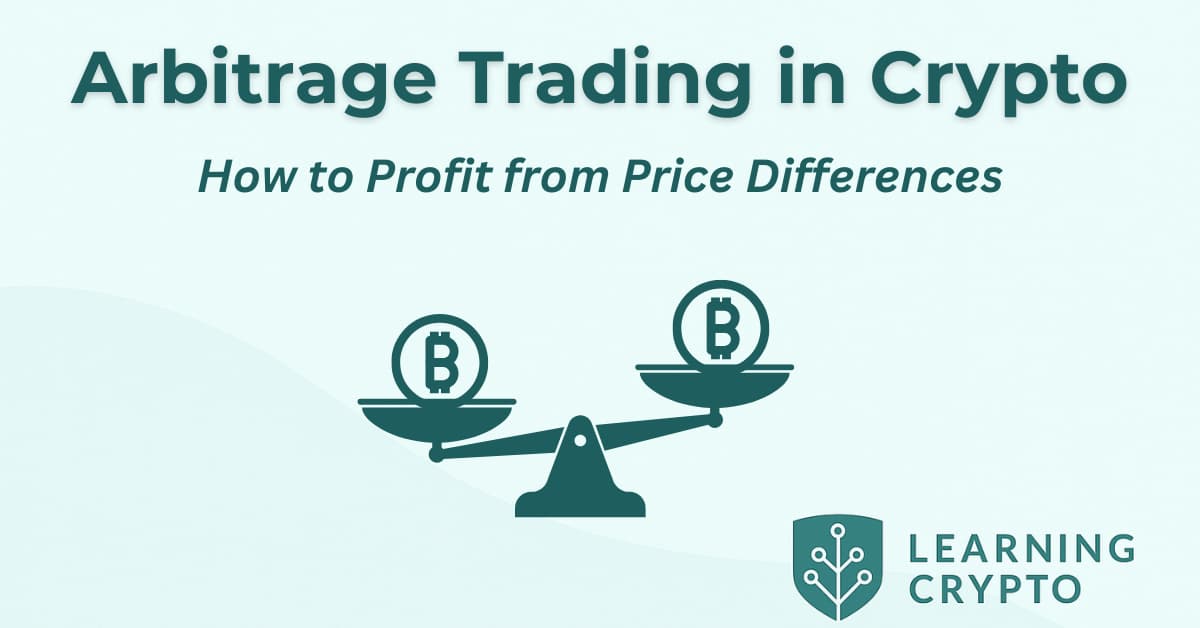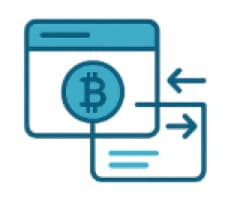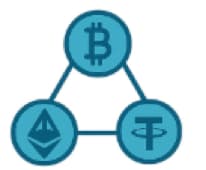Arbitrage Trading in Crypto: How to Profit from Price Differences
Arbitrage trading is a way to profit when the same asset trades at different prices across multiple markets. Due to market fragmentation, these opportunities pop up constantly in crypto.
Sounds like "free money," right? Well, it's a lot more complex than that. While the idea is simple, making it work in real markets takes skill, speed, and the right tools. The days of easy arbitrage wins are mostly behind us, but opportunities still exist for those looking for a challenge.
What This Guide Covers
Here's what you'll learn:
What arbitrage trading is and why price differences exist in crypto markets
All major types of crypto arbitrage: spatial, temporal, triangular, and statistical
Step-by-step mechanics of finding and executing arbitrage opportunities
Tools, platforms, and technology used by successful arbitrage traders
Real costs and barriers that cut into your profits
Why arbitrage opportunities are becoming harder to find and more competitive
Risk factors that make "risk-free" arbitrage less risk-free than it appears
What Is Arbitrage Trading in Crypto?
The Basic Idea and Definition
Arbitrage = simultaneous buying and selling of identical assets in different markets |
You're exploiting price differences that exist temporarily across platforms. In theory, it's "risk-free" profit from market inefficiencies.
In crypto, this means the same digital asset trading at different prices on different exchanges. The aim is to capture price differences before markets correct themselves.
Here's how it works: Bitcoin might trade at $100,000 on Exchange A and $100,150 on Exchange B. An arbitrage trader would buy on the first exchange and sell on the second, and pocket the $150 difference minus fees.
Why Price Gaps Exist
Crypto markets are still fragmented. Unlike stock markets, there isn’t one central exchange. Instead, there are hundreds of platforms worldwide. Each has its own liquidity, rules, and demand.
Here are the main reasons prices don’t always match:
Liquidity differences – Smaller exchanges may not have enough buyers and sellers to keep prices in line.
Regional demand – A token may be more popular in Asia than Europe, pushing local prices higher.
Network and transfer delays – Moving coins between exchanges isn’t instant. Delays create short-lived price gaps.
Regulatory differences – Some regions restrict withdrawals or fiat pairs, which affects prices.
How It Differs From Traditional Finance
In stocks and forex, arbitrage is limited because markets are more connected and heavily regulated. Crypto is different:
It’s open 24/7.
Price swings are bigger.
Hundreds of exchanges operate independently.
Rules vary by country.
This makes crypto fertile ground for arbitrage but also far more competitive.
Types of Crypto Arbitrage Trading
Arbitrage comes in several different forms, each with its own trade-offs between complexity and potential returns. While none are easy money in 2025, understanding the options helps you see what's actually possible versus what's just theory.
Spatial Arbitrage (Cross-Exchange)
This is the most common form. When prices differ, you buy on Exchange A and sell on Exchange B.
Example: Bitcoin at $84,000 on Coinbase but $84,300 on Kraken. You'd buy on Coinbase and sell on Kraken for a $300 gross profit.
The challenges include transfer times between exchanges, withdrawal limits, and calculating all the fees involved. Your capital is also tied up with your funds sitting on multiple exchanges.
Temporal Arbitrage (Time-Based)
This exploits price differences across time periods. You might buy during low-liquidity hours when prices dip, then sell during high-activity periods when demand pushes prices up.
Some traders focus on predictable patterns, like buying during Asian trading hours and selling during European morning sessions. It's less common than spatial arbitrage but can work with proper analysis.
Triangular Arbitrage
This uses three different currencies to exploit pricing inefficiencies. To profit from mispriced trading pairs, you might do a USD → BTC → ETH → USD loop.
Example: If the BTC/USD, ETH/BTC, and ETH/USD pairs are slightly misaligned, you could cycle through all three and end up with more USD than you started with.
This happens on single exchanges when trading pairs get out of sync. The opportunities disappear quickly, so most successful triangular arbitrage is automated.
Statistical Arbitrage
This uses math models to find temporary price differences between related assets. You might go long on an underperforming coin while shorting an overperforming one, betting they'll return to their normal relationship.
Pairs trading is common here. If Bitcoin and Ethereum usually move together, but one suddenly diverges, you could bet on them converging again.
This requires strong technical analysis skills and is more complex than other arbitrage types.
DeFi Arbitrage Opportunities
Price differences between centralized and decentralized exchanges create new arbitrage opportunities. DEXs like Uniswap sometimes have different prices than centralized exchanges like Binance.
Flash loan arbitrage lets you borrow funds for same-block trades, capturing profit without putting up your own capital. You borrow crypto, execute the arbitrage, repay the loan, and keep the profit - all in one transaction.
Yield farming rate differences across DeFi platforms also create arbitrage opportunities, though these are more about capturing rate differences than price differences.
How to Execute Crypto Arbitrage Trading
You have two paths here: manual or automated. One is a complete waste of time, and the other requires serious money and technical skills. Pick your poison.
The Truth About Manual Arbitrage: Don't Bother
To be blunt, doing arbitrage by hand in 2025 is like showing up to a Formula 1 race with a horse and buggy. Price discrepancies now last seconds, not minutes.
By the time you spot an opportunity, calculate the fees, and place your orders, automated bots have already eaten the profit.
Manual arbitrage worked in 2017 when Bitcoin could trade between exchanges for hours at different prices. Those days are dead and buried.
What Actually Works: Automation
If you're serious about arbitrage, you need:
Price monitoring software that tracks multiple exchanges simultaneously. Some free options exist, but paid tools are usually faster and more reliable.
API connections to exchanges for real-time data. Most major exchanges offer APIs, but setup can be technical.
Automated trading bots for quick execution. Nearly all profitable arbitrage now relies on automation because humans just can't compete with bot speed.
Portfolio management tools to track positions across platforms. You need to know exactly what you own and where.
Fee calculators to determine true profitability. What looks like a good opportunity might lose money after all costs.
Capital and Account Setup
You'll need to:
Maintain balances across multiple exchanges. This ties up capital that could be earning returns elsewhere.
Complete KYC verification for higher withdrawal limits. Most exchanges cap unverified accounts at low daily limits.
Understand each platform's procedures for deposits and withdrawals. Transfer times and minimum amounts vary widely.
Calculate minimum capital requirements. 2025's typical arbitrage opportunities range from 0.1% to 2%, so you need enough capital to make meaningful profits.
Consider the tax implications of frequent trading. Each arbitrage trade might create taxable events.
Why Crypto Arbitrage Is a Rigged Game
Crypto arbitrage has become a game in which the house almost always wins. And the house isn't you. It's the firms running million-dollar bot farms with direct exchange connections.
Fees Will Destroy Your Dreams
You see Bitcoin at $100,000 on one exchange and $100,200 on another. That's an easy $200 profit, right? Wrong.
Here's what actually happens:
Trading fees on both sides (usually 0.1% to 0.5% each)
Withdrawal fees to move funds between exchanges
Network fees that spike during busy periods
Conversion costs if you need to switch between different base currencies
Add it all up, and fees often eat your entire profit margin. What looked like easy money becomes a guaranteed loss. This math problem exists for every trade - most apparent arbitrage opportunities vanish once you factor in real costs.
The Speed Problem
By the time you notice a price difference, it's already too late. Professional arbitrage bots are connected directly to exchange servers with sub-millisecond response times. You're competing against systems that can complete trades faster than you can blink.
Think of it like trying to grab dollar bills in a wind tunnel while wearing oven mitts, while robots with perfect reflexes are doing the same thing.
The Capital Trap
Want to make meaningful money from 0.5% price differences? You need serious capital. To make $1,000 profit, you'd need to trade $200,000 - and that's assuming everything goes perfectly.
But you need that money sitting idle across multiple exchanges, earning nothing, just waiting for opportunities. Meanwhile, that same $200,000 could be earning 5-15% annually in DeFi.
Why the Barrier Is So High
Arbitrage isn't broken - it's just evolved beyond retail reach. The players who dominate now have:
Direct data feeds from exchanges (faster than public APIs)
Co-located servers next to the exchange data centers
Millions in capital to make tiny margins worthwhile
Custom software developed by teams of engineers
Preferential trading fees from high-volume agreements
You're not competing on a level playing field. You're bringing a calculator to a supercomputer fight.
Technology and Automation in Arbitrage Trading
Link Alt text: Futuristic blue wireframe gears symbolizing automation and advanced technology
The Rise of Arbitrage Bots
Automated systems monitoring thousands of price pairs simultaneously now dominate arbitrage trading.
These bots offer:
Sub-second execution times that humans can't match
24/7 operation across global markets
Multiple trading execution at the same time
Professional traders and institutions using advanced systems
How Bots Killed the Party
Bot trading completely flipped the arbitrage world upside down. These automated systems scan thousands of price pairs every second, then pounce on opportunities faster than any human could even register them.
What used to be price gaps that lasted minutes or hours now vanish in the blink of an eye.
The profit margins tell the whole story. Back in crypto's early days, you might find Bitcoin trading 10% higher on one exchange versus another.
Today? You're lucky to find differences of 0.5% that last more than a few seconds. The bots have essentially turned arbitrage into a high-frequency trading arms race where only the fastest and best-funded players can compete.
Building or Buying Arbitrage Systems
Your options include:
Commercial arbitrage software and services with monthly fees
Custom bot development requires programming skills and ongoing maintenance
API management and exchange integrations
Risk management and position monitoring systems
Most retail traders find it difficult to build effective systems beyond their technical abilities.
Risks in Crypto Arbitrage Trading
Execution Risk
Things that can go wrong:
Prices changing during trade execution
Partial fills leave you with unhedged positions
Exchange technical issues prevent order completion
Network congestion delays transactions
Counterparty and Platform Risk
Exchange-related risks include:
Exchange hacks, freezes, or sudden closures
Regulatory changes affecting specific platforms
Withdrawal restrictions during market stress
Account freezes due to high-frequency trading patterns
Market Risk
Market conditions that hurt arbitrage:
Extreme volatility eliminates arbitrage windows
Flash crashes create false opportunities
Liquidity crises make exits impossible
Correlation breakdown in statistical arbitrage
Legal and Tax Considerations
Rules and Regulations
Arbitrage trading sits in a legal gray area that varies wildly depending on where you live.
Most countries don't specifically ban it, but that doesn't mean you're in the clear. Some places have restrictions on moving crypto across borders, which can kill cross-exchange arbitrage opportunities.
If you're trading frequently enough to make arbitrage worthwhile, you might trigger reporting requirements that treat you like a professional trader rather than a casual investor.
And here's something most people don't think about: constantly moving money between exchanges can look suspicious to regulators who are watching for money laundering.
Your perfectly legal arbitrage activity could flag automated systems and land you in compliance hell.
Tax Implications
We aren’t tax specialists, so consult a professional if you are considering arbitrage, but issues you might want to consider are:
Each arbitrage trade potentially creates taxable events.
Frequent trading may qualify as business income vs. capital gains.
Complex record-keeping requirements across multiple platforms.
Expect Different tax treatment in various countries.
Keep detailed records of all trades, fees, and transfers.
Is Crypto Arbitrage Worth It in 2025?
Honest View for Retail Traders
The golden age of easy arbitrage is over. Bots and institutions scoop up most opportunities. Retail traders face:
Slim margins
High competition
Heavy fees
Unless you have strong coding skills, solid capital, and time, it’s not going to be worth pursuing as your main strategy.
Better Ways to Make Money in Crypto
If you're dead set on making money from crypto, arbitrage probably isn't your best bet. There are easier ways to earn returns without competing against million-dollar bot farms.
DeFi yield farming and staking offer much better opportunities for regular people. You can earn just by staking Ethereum or providing liquidity to DeFi protocols. Sure, there's smart contract risk and potential impermanent loss, but at least you're not racing against algorithms that execute trades in microseconds.
Long-term investing in solid crypto projects beats trying to scalp 0.1% arbitrage profits any day. Buy Bitcoin or Ethereum, hold for a few years, and you'll likely do better than grinding out tiny arbitrage wins while getting eaten alive by fees.
Learning other trading skills makes way more sense. too. Swing trading, trend following, or even basic technical analysis have less automated competition than arbitrage. Bots dominate arbitrage because it's pure math and speed. Other trading styles still reward human intuition and pattern recognition.
The time and energy you'd spend setting up arbitrage bots, managing exchange accounts, and monitoring tiny profit margins? You could use that to learn DeFi strategies that actually pay decent returns.
Building Your Crypto Trading Knowledge
Arbitrage trading exploits market inefficiencies for profit, but things have changed dramatically. While 2021-2023 sometimes saw double-digit percentage price gaps during volatile periods, 2025's typical arbitrage opportunities range from 0.1% to 2%.
The opportunities exist, but they're increasingly competitive and require major preparation. Most successful arbitrage traders now use automated systems, big capital, and deep technical knowledge.
For most individual traders, arbitrage works better as part of a broader crypto plan than as a standalone method. First, focus on building your overall crypto knowledge and trading skills.
At LearningCrypto, we help you develop the knowledge and give you the tools for crypto success:
Learn through AI-powered education with personalized crypto lessons
Track your holdings with portfolio management tools across multiple exchanges and wallets
Analyze markets with advanced data and analytics to spot trends and opportunities
FAQs
Is crypto arbitrage trading still profitable in 2025?
Yes, but really only for well-equipped, advanced traders. Easy opportunities have become rare due to increased competition from bots and institutional traders. Success requires automated tools, big capital, and access to low-fee exchanges.
How much money do I need to start arbitrage trading?
The minimum depends on exchange limits and profit margins. 2025's typical arbitrage opportunities range from 0.1% to 2%, so you need enough capital to make profits worthwhile after fees. You'll need at a bare minimum $10,000-$50,000 spread across multiple exchanges.
What tools do I need for crypto arbitrage trading?
You'll need price monitoring software, exchange APIs for real-time data, automated trading bots for execution, and portfolio management systems. Most profitable arbitrage now relies on sophisticated automation because manual trading can't compete with bot speed.
Can I do arbitrage trading without bots?
Manual arbitrage is extremely difficult in 2025. Price discrepancies typically last seconds rather than minutes or hours, making human execution nearly impossible for most opportunities. While some longer-lasting discrepancies exist on smaller exchanges, consistent profits pretty much will always require automation.
Disclaimer: This article is for educational purposes only and does not constitute financial advice. Cryptocurrency investments carry risk; you should always do your own research before making any investment decisions.
Disclaimer: This article is for educational purposes only and does not constitute financial advice. Cryptocurrency investments carry risk; you should always do your own research before making any investment decisions.






